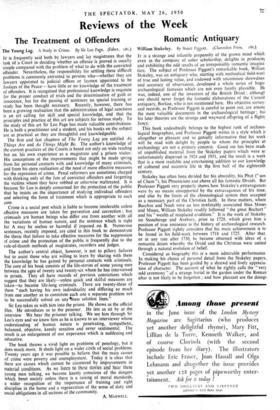Romantic Antiquary
William Stukeley. By Stuart Piggott. (Clarendon Press. ifls.) IT is a strange and infantile propensity of the grown mind which. even in the company of sober scholarship, delights in producint and exhibiting the odd results of an irresponsibly romantic imagina- tion. The subject of Professor Piggott's remarkable book, William Stukeley, was an antiquary who, starting with methodical field-worl of true and lasting value, and endowed with uncommon shrewdnes! and accuracy of observation, developed a whole series of bogus archaeological fantasies which are not even faintly plausible. He was, indeed, one of the inventors of the British Druid ; althougl- one should never forget the fantastic elaborations of the Cornist antiquary, Borlase, who is not mentioned here. His objective survey: and records, as Professor Piggott is careful to point out, are amonf the most valuable documents in the archaeological heritage • bui his later theories are the strange and wayward offspring of a flights fancy.
This book undoubtedly belongs to the highest rank of archaeo- logical biographies, and Professor Piggott writes in a style which is altogether so pleasant and so genially informative that his work will be read. with delight by people to whom the principles of archaeology are not a primary concern. Good use has been madc of unpublished material from the Stukeley papers which were sc unfortunately dispersed in 1924 and 1931, and the result is a work that is a most readable and entertaining addition to our knowledge of cultured and eccentric life in th, first half of the eighteenth century.
Stukeley has often been derided for his absurdity, his Phut (" son of Cham "), his Phoenicians and above all his fantastic Druids. But Professor Piggott very properly shows how Stukeley's extravagances were by no means unsupported by the extravagances of his time, and also by the limits of the chronological system then accepted as a necessary part of the Christian faith. In these matters, where Bacchus and Noah were no less irrefutably associated than Moses and Muses, William Stukeley readily followed " the great Bochart " and his " wealth of misplaced erudition." It is the work of Stukeley on Stonehenge and Avebury, prior to 1728, which gives him a position of true eminence in the history of archaeological research. Professor Piggott rightly considers that his main achievement is to be found in his field-work between 1718 and 1725. After that, or at any rate after 1730, he became obsessed with ideas of a romantic deism whereby the Druid and the Christian were united through a natural evolution of belief.
Considered as biography this is a most admirable performance. In making his choice of personal detail from the Stukeley papers, Professor Piggott has been guided by a shrewd and lively apprecia- tion of character. The account of what he rightly calls the " very odd ceremony " of a strange burial in the garden under the Roman altar is not likely to be forgotten and how pleasant are the doings
of the gentlemen who called themselves " Roman Knights " and addressed each other with a playful solemnity as Galgacus or Cingetorix! This was in the earlier days, before the Druids had made themselves the masters of Stukeley's mind and the weird originators of every fantasy. And so, from the time when he abandoned the practice of medicine and entered the Church (a visible transition which had its counter- part in a mental chance), William Stukeley was a sad example of that rejection of the empirical method which has led even modern archaeologists, if not to disaster, at least to positions of great insecurity ; for the most lamentable of all the hindrances to archaeology is a romantic disposition. The causes of that rejection were probably, as Professor Piggott so acutely surmises, due to a deep psychological disturbance. From the time when he overlaid his early and honest work with Druidical embroidery, Stukeley had forsaken the discipline of science which alone can give archaeology a permanent value and an honourable place in the study of man. He had become a Christian Druid. Yet one cannot read this book without a great warming of the heart towards William Stukeley, a man whose very foibles were presented in a manner so charming and with such a purity and simplicity of intention that we never cease to think of hini with respect. For this revival of a character so interesting and so attractive in his own right Professor Piggott certainly deserves our gratitude and applause. He has written a book which is doubly excellent, and which every student of the eighteenth century—indeed, every student of the English character







































 Previous page
Previous page